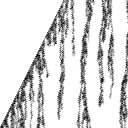 (Requires browser Java support.)
(Requires browser Java support.)Percolation is the propagation of activities through connected space. The essences are that there is a source of the activity and all the other regions of the space can not be active if non of their neighbors are active. For example, in the percolation of coffee making, the top surface of the grounded coffee that's receiving the water is the source and the activity is to have water flow. Another example is forest fire. The source could be a camp fire and the activity is burning.
Directed percolation is percolation with a special direction along which the activity can only propagate one way but not the other. Some examples of percolation has a straight forward extension to the directed percolation when we include the consideration of the time as the special direction.
I've done some work on directed percolation, Active width at a slanted active boundary in directed percolation, Phys. Rev. E 60, 2496 (1999).
You may have a look of a java applet showing
the system I studied.
 (Requires browser Java support.)
(Requires browser Java support.)
Directed percolation (DP) describes a very generic universality class in the absorbing state phase transition. For example, consider population spreading with the birth rate as a variable control parameter. With other parameters, such as, diffusion constant and death rate, fixed, when the birth rate is high, the system will evolve into an active stationary state with a positive population density. But, at low birth rate, the system will soon evolve into an empty state with zero population density which we call the absorbing state because once the system reaches this state, it stays forever.
There is a caveat in the above description. That is, it only make sense in the thermodynamic limit, meaning the system must have infinite size. When a system is finite and ergodic, there exists a finite time length that, starting with any state, the absorbing state of the system will be reached with finite probability. Therefore the surviving probability for the system to escape the absorbing state decays exponentially in time. In this sense, the active stationary state mentioned above does not exist.
With the two phases established above, the system becomes critical at the transition point. That is it exhibits long range correlation and lack of identifiable scales. Such state of the system is characterized by its scaling behaviors, specifically, the scaling exponents. Though it has long been sought by the physicists, the exact exponents characterizing the DP universality class remain unsolved.
From what we learned in equilibrium critical phenomena, most critical systems are thought to be conformal invariant. As a result, in two dimension, the correlation functions can only take specific forms and their scaling exponents be rational numbers. However, in dynamical systems, we don't necessarily have conformal invariance nor even isotropy in the case of two dimensional DP. Nonetheless, in the early attempts of understanding the DP universality class, people were still inclined to express their numerical results in terms of fractions of integers. This tendency is now abandoned and people generally believe the critical exponents characterizing the DP universality class are irrational numbers. Although, not much is known apart from numerical evidences.